
Paquebot - An Art Deco Subcategory
The French style 'Paquebot' is often said
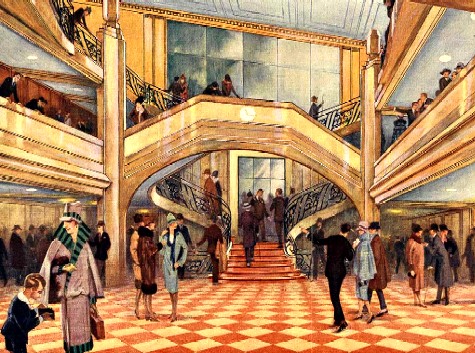
Paquebot, Grand Hall, Ile-de-France, Artist Leo Fontan, Brochure,
Photo: Philippe Fuzeau, 1927, Conaissance des Arts
to be the French equivalent of the American Streamline Moderne design. During the 1920s, the French used the term to refer to the decorating style used on some of their luxury ocean liners. Paquebot was originally a reference to the decor aboard the French ocean liner Île-de-France, which traveled between Le Havre to New York from its launch in 1927 until 1939. In fact, the word paquebot refers to a mail delivery boat or 'packet boat'. Although the connection is not immediately apparent, the Île began transporting mail in 1928, establishing her secondary role as a packet boat. Apparently, this aspect of the ship, combined with her Art Deco influenced decor, caused the term 'Paquebot' to refer to this unique style. Architects and interior designers picked up on the idea, giving late 1920s and 1930s Art Deco a maritime spin. Among those who embraced Paquebot was French interior decorator Jacques-Émile Ruhlmann. Images of some of his original designs reveal curved surfaces reflecting the bow of ships, porthole designs and the horizontal lines a long, flat ship necessary had.
Among the elements of the style listed in the French Wikipedia entry which suggest "the very fashionable transatlantic cruise liners of the time" are:
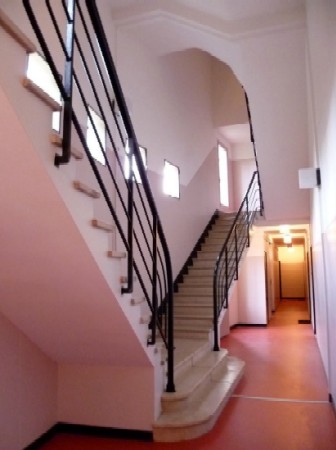
La Paquebot, Apartment Building, Paris, Architect Pierre
Patout, 1934, Pinterest
- Symmetry - Much of a ship's design is necessarily symmetric, although certainly not all of it.
- Geometric Shapes - Described by the french Wikipedia entry on Paquebot as "modern, sober and refined".
- Long Horizontal Lines - Unlike Zigzag and Jazz Moderne which tended to focus on vertical lines, Paquebot and Streamline Moderne both embraced the horizontal. This is presumably similar to the long horizontal lines of cruise ships.
- Rounded Surfaces and Corners - Contrasting the long vertical lines, reflecting the bow of many ships.
- Portholes - In non-ship Paquebot designs and buildings, porthole-like elements are found in wall openings and windows as well as some mirrors and similar objects.
- Architectural Ship-Like Structures - Paquebot building exteriors sometimes have bows, cantilevered terraces and balconies, large bay windows, ship-like railings, gangways and similar elements. Ship-like railings are sometimes found on stairs and other mentioned elements are occasionally used in furniture. The image at left has stairways which evoke gangplanks and railings similar to ships.
Although Paquebot style didn't actually become popular until the 1930s, hints of it can be found in Paul Poiret's designs for a péniche (barge) which were shown at the 1925 Exposition Internationale des Arts Décoratifs et Industriels Modernes. Poiret's designs (seen below) contain only nascent hints of what would become Paquebot combined with 1920s Art Deco styles. Still, rounded surfaces are everwhere, the bias of the rooms is generally horizontal and there are portholes, railings an large bay windows in some of these images..
 Hints of Paquebot in Paul Poiret's Designs for the Paris 1925 Exposition - From Left: Living Room; Dining Room; and Bedroom
Hints of Paquebot in Paul Poiret's Designs for the Paris 1925 Exposition - From Left: Living Room; Dining Room; and Bedroom
Another ship which helped was considered a forbear of Paquebot style was the Atlantique. She was completed in 1931, and set sailing between Europe and South America. Although this ship is often cited as being executed in Paquebot style, interior images of first class compartments seem to be much more in line with 1920s elements of Zigzag and Jazz Moderne styles than those of Paquebot and Streamline Moderne. Here are vertical, not horizontal biases, few curving surfaces or porthole features, Deco-style chevrons and grids with sharp lines. High class furnishings in France at that time focused on custom-made Art Deco pieces. It is primarily in the second class accommodations of l'Atlantique where the curving, Paquebot style is evident. (See the image for an example.) l'Atlantique's career was brief, however. She caught fire in 1933, gutting much of the interior.
Beginning in the early-mid 1930s, Paquebot style found its way into buildings. Among them was Jacques Carlu's decor for the Eaton Le 9e Restaurant in Montreal, completed in 1931. Here curved corners with speed lines, horizontal biases and round porthole-like designs are evident. (Note that speed lines were more indicative of the American Streamline Moderne style.) Another Pacquebot building was Paul Cavrois' house, which he commissioned Robert Mallet-Stevens to design in Northern France. Completed in 1932, every room has subtle aspects of the maritime style. Some images of these buildings can be seen below.
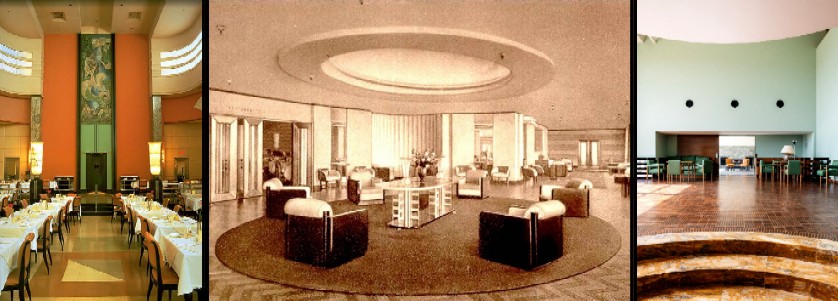 Elements of Paquebot in Buildings - From Left: The Modern Dining Room of Eaton Le 9e Restaurant; Original Lobby of the Restaurant; Salon of Villa Cavrois
Elements of Paquebot in Buildings - From Left: The Modern Dining Room of Eaton Le 9e Restaurant; Original Lobby of the Restaurant; Salon of Villa Cavrois
Pierre Patout, who worked on both Île-de-France and l'Atlantique designed a building actually named 'La Paquebot' the exterior or which resembles an ocean liner. The few online images of the interior of this apartment building have elements of Paquebot design, although they are not as evident as the other two buildings mentioned. There is an image below for each of these three buildings. A variety of other Paquebot style buildings were created in the mid 1930s, but let's move on to the last ship of interest here.
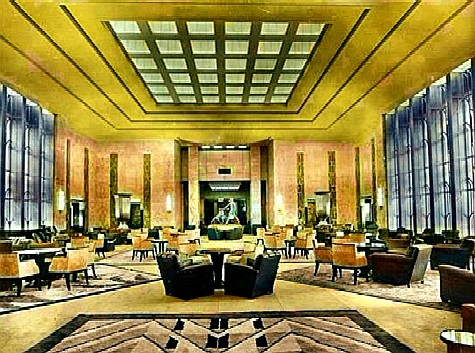
First Class Lounge of the Atlantique, c. 1931. Chevrons, Vertical Bias and Edges
a-plenty. Pinterest
One other ship is often cited as lending its design concepts to Paquebot style - SS Normandie. She began construction 1931, being completed in 1935. Like the Île-de-France, she sailed from Le Havre and New York, although, like l'Atlantique her sea career was short - only 4 years. The Normandie used many of the same designers and architects as had worked on the other two ships. Although designed and built in the middle of the Paquebot period, her style is more like that of the l'Atlantique, with an Art Deco feel. Here again we find striking designs, vertical bias, sharper corners and bold lines.
In the end, the primary source of many Paquebot elements appear to come from the Île-de-France, where the designers had to work with the natural lines of the smaller vessel which featured curving surfaces, port holes and long horizontal lines into their interiors. Both l'Atlantique and Normandie were larger, more luxurious vessels, being designed with spaces which could accommodate the sharper horizontal elements of classic 1920s Art Deco Zigzag and Jazz styles. However, there are still examples from these vessels, one of which can be seen below.
The essence of Paquebot styling was found primarily in buildings during the heyday of its popularity. Some French websites use the American term Streamline Moderne ('Mouvement Streamline") to refer to the style instead of Paquebot.. (See the Du Grand Art website for example.) French Wikipedia titles it Style Paquebot, but equates it to Streamline Moderne in the first sentence of their summary description. Nevertheless, it brought some unique elements to the 1930s offshoot of Art Deco.
References Not Cited in the Above Text:
Scott Houston McBee, "The Last Voyage of the SS Ile de France", New York Social Diary, gathered May 12, 2024
"Normandie (paquebot)", French Wikipedia, gathered May 12, 2024
"L'Atlantique", Wikipedia, gathered May 12, 2024
Original Facebook Group Posting
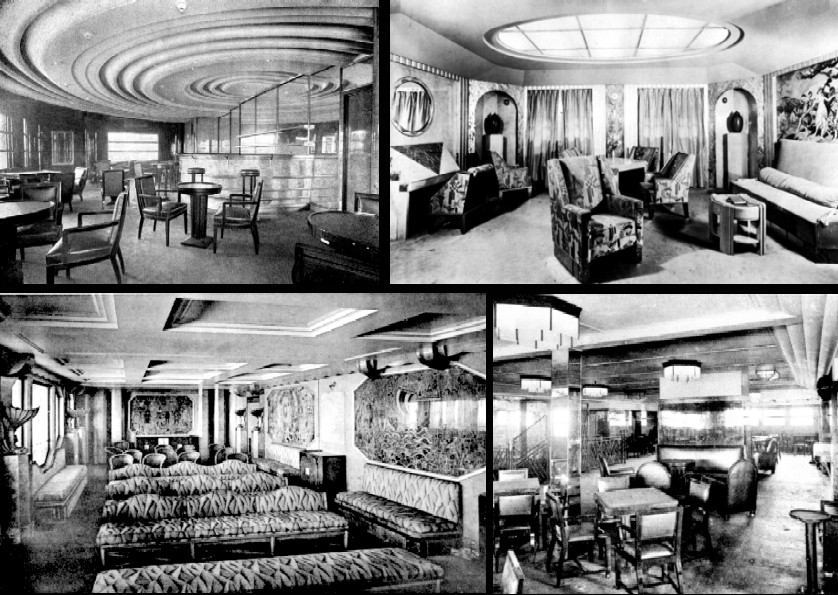 Interiors of Paquebot Style in French Ocean Liners . From Top Left: Second Class Smoking Room on the Atlantique; First Class Sitting Room, Île-de-France; Theater on the Île-de-France; Second Class Smoking Room, Île-de-France
Interiors of Paquebot Style in French Ocean Liners . From Top Left: Second Class Smoking Room on the Atlantique; First Class Sitting Room, Île-de-France; Theater on the Île-de-France; Second Class Smoking Room, Île-de-France